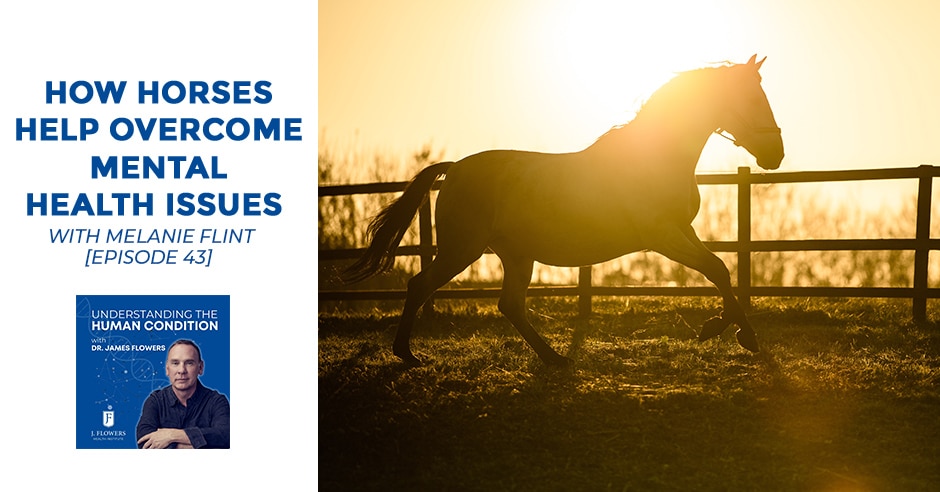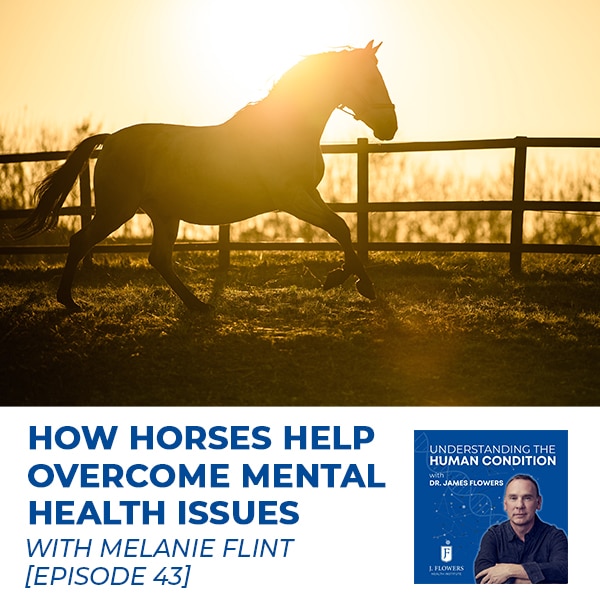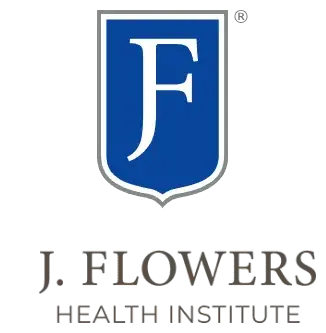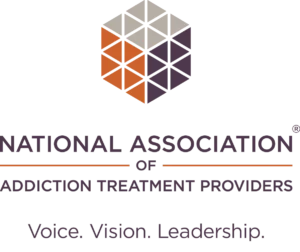
The benefits of equine therapy for people struggling with addictions and mental illness. Learn several life skills that a horse can teach better than a human through equine therapy with celebrity pain & mental health therapist Dr. James Flowers, co-host Robin French, and VIP guest host Melanie Flint.
—
Listen to the podcast here
How Horses Help Overcome Mental Health Issues With Melanie Flint [Episode 43]
I would like to introduce our trauma and equine therapist Melanie Flint. Melanie is a wonderful clinician and I have known her for a long time. I’m very excited to be able to co-host the show for her.
We are going to share the benefits of equine therapy for people struggling with addictions and mental illness. You will also learn several life skills that a horse can teach better than a human through equine therapy. I’m going to tell you a little bit about Melanie Flint, for those who don’t know already. Melanie Flint serves as the Founder and Clinical Director of JEM Wellness & Counseling in Houston Texas.
She’s a licensed clinical social worker, certified group psychotherapist, and equine-assisted psychotherapist with sixteen years of experience treating individuals, couples, families, and groups and speaking to organizations nationwide. Melanie specializes in anxiety disorders, trauma recovery, and relationships with a special interest in supporting parents and girls women and mothers empowerment. Welcome.
Thank you. I’m so glad to be here. Thanks for having me.
How do you two know each other?
Many moons ago I was running a treatment center for young women and Melanie came on as a therapist and then ultimately came on and took over our equine program that was in existence and developed it into this magical place where everybody including staff wanted to be in the barn.
It was magical. The barn was a place where people who knew about horses seemed to be people who were afraid of horses and stayed away from them. Through my time there I tried to make it a place of gathering. We did our equine-assisted psychotherapy. We did learning workshops. We had riding lessons. We had a show where our riders could demonstrate what they had learned and we had music and we gathered. It was a beautiful space I felt and everyone participated.
Some great work with parents and we painted horses on Halloween. We have a little parade. That was wonderful. Those were good times.
What issues can equine-assisted psychotherapy help specifically?
Equine-Assisted Psychotherapy
I would say trauma first and foremost and relationships as well anyone struggling with issues in relationships, whether it’s isolation, the relationship with ourselves, the relationship with our partner, our children, our families, and our friends. Deeper connections anxiety depression. We work with a lot of veterans with equine-assisted therapy, so PTSD. I have treated many clients with eating disorders as well. It’s pretty comprehensive. The horses will mirror for us what we are experiencing and how we are showing up and they will show us through the guidance of the therapist and the equine specialists. It’s a team effort on how we can shift in order to deepen our relationships and it’s powerful work.
One of the things that I love so much is how effective of a modality it is to add to more traditional talk therapy. Would you talk a little bit about that? People may be that have challenges processing verbally, how can the horses be so powerful as a tool?
Talk therapy is amazing. I do a lot of my work in this office. Part of what humans talking about is the human condition. Part of what we as humans that we all share is that when we experience life, that’s where so much growth in learning and healing can happen and hardship as well. When we are in the office, we talk about it all. We facilitate healing when we are out in nature with animals and here with equines. We see it in action.
We are walking the walk. We are engaging multi-sensory with our healing process. The horse is of course the focus in this case. When we are in front of another 1,200 pounds in sheer size, there’s a different meaning for each person. Their sensitivity is being prayed to animals. They bring with them a multitude of sensitivity that we as predators don’t have. We can socialize, some of us come innately with many different areas of connection around this.
The horses come with sensitivity for sound, energy, feel, and sight. All these different areas that when we engage with them and we interact with them we touch them, we groom them, we connect with them. It’s through that experience that a lot of the growth can happen. In addition as adjunct therapists, lots of times we will have office work and then do four sessions on the ranch or once a month we will meet up there as an adjunct that help conceptualize and bring the concept into the dome of reality and then the clients put that into their lives and see it play out.
We have enjoyed having you working with our clients and J Flowers and they have very much enjoyed it as well. Any stories that shall remain nameless, but any experience that you can share with us that might be fun to put things in context?
There are so many. There are some that we have experience with individuals and some with families. I will share a family experience. Sometimes we will take relevant areas of conflict, challenge, or struggle that someone is experiencing and will facilitate an activity in a pen or an arena. We will have 1 or 2 horses. We will ask the client. Let’s say they are having struggles with boundaries. We will have some tools in the arena and we will say, “Create your bedroom or your office,” depending on who they are.
They will take some tools like cones or those swim noodles that are soft, but they are colorful and long. We will ask them to create a space for themselves and then we will have them go into the space and have them protect that space. In other words, keep your boundaries and the horses can become metaphors for life or family members crossing our boundaries coming into our space. How do we reinforce?
The horses can become metaphors for life.
I have had families come out and I might have them recreate who they are in the family, so they will go into different areas of an arena, and they might put themselves in their room or they might for a mother for example, she might hold multiple tools in her hands and feel or tell us, “I’m always juggling things. I’m going to hold all these things.”
We will have them with the horses by themselves, and I have seen families go through this process of realizing how often they cross boundaries. As parents, how considering with empathy their children’s experience never crosses their minds because we got to go, we got to do things. We talk a lot about behavior and our culture. To use a specific example. I had a family come out who I had set up their space. Their home. The horses were walking through. Now in this specific case. We had buckets of feed out there as boundaries were a huge issue. Animals and food. There’s No Boundaries.
Buckets of feed are placed throughout their setup in their home. As the horses would come through we would see how each of them reinforced their boundaries. Not only with the horses, but with each other because one family member would push their horse into the other person’s face, or one person went around and collected all to feed buckets for themselves and wanted all the attention. There was a big issue with boundaries there.
We saw these things play out, and then we could go back and process and talk about what they noticed out there. The power in these sessions is about what the client experience is. It’s not as hard as what is happening. It’s what they experience so they might come out and say, “That brown horse was like Dad. He never knocks and comes in all the time. He doesn’t respect my space.” Dad is over there going, “I wasn’t even. I was all the way over here.” They get to talk about the metaphors that the horses bring up. The behavior goes on within the family and then we get to have our talk therapy time or processing time and help them heal and restructure and move into other forms of therapy to help support the relationships. That’s one example. I have another. I can go on.
I had a session with some veterans. There was a group of them out there. A lot of trauma. Also, relationship issues were coming up and we had some full-size horses and some mini horses with us. One adult male veteran who was with us was standing. Away from the rest of the group, and said to me, “I don’t want to be with any of these horses. I don’t want to be out here.” He came out a couple of times and didn’t participate much. Through some comments and processing, we came to realize that relationships were very difficult for him. He had pretty much isolated himself from most people after returning from his appointment.
The third time he came out. The same offering of tools and supplies was out there for them to use during part of the session and he ended up picking up a grooming bucket and going over and being drawn to this one rather large horse. He went over and started grooming this horse and spent the rest of the session with the horse.
By the end of it, he was very emotional and he came back to the circle and didn’t say much but I received a call later. The beauty of so much of our work is that we might bring up a lot in our sessions. The work happens after. The realization, healing, and conversation. He called me and he said, “I realized I want so much more in my life. I didn’t think I was worthy of it. I didn’t think I was allowed,” because of everything he had experienced. It unlocked his heart, unlocked his life and he came back again and again and deepened those relationships. It’s very powerful.
You know what I found fascinating was that you can also help those with spinal cord injuries and paralysis and MS.
Yes, we can. It’s a little bit of a different process because being with the horses it can be physical, the sheer walking. It is all ground work though. There’s no riding involved. In some modalities, there can be but for the majority of our work, it is all on the ground. As long as we can get them out there with support. If they have companions or caregivers, that’s one of the reasons we have a team. I am a mental health-focused person and a people-focused person.
The other part of my team is my equine specialists who focus more on horse behavior and what’s happening there, and then the horses complete our team. If we can get them out there then we can keep the space safe. That’s our top priority and allow them the same process as someone who isn’t in a wheelchair.
I also read that the autism community is a large portion of those who use equine therapy. Is that true?
It can be for sure. Different programs will offer different modalities to help treat different populations. That can be very true because of folks on the autistic spectrum. There can be difficulty with connection, relationships, and empathy and looking for those social cues. It’s a beautiful wealth of experience that can happen out there to deepen awareness and relationships.
Different programs will offer different modalities to help treat different populations.
I can see how this was beneficial to a nonverbal person.
What’s interesting is when a person first would go at least the way we facilitated when we do this together. The horse will either select you or not. I don’t think that’s the right way to say it exactly but the horses gravitate to different people and oftentimes, Melanie would point out things to me like, “These horses like this girl. Hard-headed and doesn’t behave.”
They choose their like-minded partners.
It creates an environment for some interesting work to happen because there’s this push-pull as they create their relationship together. Am I saying that right?
Very true. We saw this stuff happen where let’s say we were at a treatment facility that had all females. We had one of the adult women out there. She struggled with boundaries. She had some early life trauma and a very difficult time with boundaries. The horse too was drawn to her and likes to push boundaries. Didn’t like the rules. He could identify someone who didn’t like or know how to have boundaries and he went straight to her and he bullied her a little bit. I’m thinking of one person. He bullied her a bit and a lot of wonderful work happened around boundaries for her. She got pushed around a little bit and it forced her to say, “Wait a minute. I don’t like that or that isn’t something that works for me.” We took it back to the office or the barn office as it were and worked on those things.
Getting Into The Field
How did you get into this field? I’m curious.
I got the horse bug when I was a kid. I fell in love with horses and rode a little bit. Throughout my life, I was around them as often as possible. In graduate school, I had an internship by choice that said the recovery center had a horse so I loved that idea and I went out there and they were doing the work out there. I was introduced to it through someone who’s been in this work for decades and she was very pregnant. She said, “I’m glad you are here. I’m going to be on this side of the arena. You go on in and I will walk you through it.” She taught me that way and so I started facilitating with her support. When I went through my career a little more. I realized I wanted to utilize this modality and when I was working with Shay I became fully certified and now here we are.
It was such a pleasure to get to know you way back then and an extreme pleasure to get to bring you into what we are doing at J Flowers. Our program consists of a lot of different things but people come in for comprehensive diagnostic evaluation first, and sometimes we will identify trauma or eating disorders, all those things that you mentioned that do benefit greatly from equine-assisted therapy being a part of what they do.
Since we have Incorporated the equine piece into our wellness program, I think it’s added richness and diversity. It’s not something that people expect since we are right in the middle of the city, but it’s a nice little break from the hubbub, the hustle and bustle, and traditional talk therapy. The groups and the offerings that you have been able to offer. It’s such a bonus for us. It continues to enrich the breadth of things that we offer at J Flowers and the experienced clinicians who work with us. I’m honored to have you be a part of that team of world-renowned clinicians.
Thank you, Shay. I will tell you working with you guys has been so wonderful. Your patients come out. We have them out on Fridays and they get to almost sometimes they finish their programming for the day with us, and sometimes they have one last thing to do. They will come out and they will start to breathe differently. They share with us how wonderful it is to have this different experience of treatment, and it surprises them all the time.
Some of them remember and revive their child. They come out and they play and we will do different things with the horses and they get to have some quiet too. We meet them where they are and we take them at their pace. I will say your patients have responded beautifully to the work. Thank you for the opportunity. It’s been a joy.
Likewise. It’s funny because our client base is so diverse. We work with adolescents and young children all the way up to 70 and 80-year-old people. I know that when they come out for groups, they are grouped and age-appropriate groups, but it’s been neat to see because it isn’t something that’s for your wayward teenager. It’s also for your wayward elderly father who’s a little cranky and cantankerous. It works for both. It’s been nice. I’d love to get our team out some time and do some stuff.
We would love to have you guys out.
I was even thinking about some provider event or something that we can incorporate.
I want to see you out there with some boots and horse poop. It’d be great.
We could have Robin muck some stalls. Maybe not that. I have got some cute boots. I do and a cute hat.
I like a few stalls. I enjoyed it.
Would you call it mucking?
It’s poop cleaning.
I’m not a poop patrol.
We probably are going to have to go soon, but I do think there’s some value and explaining to our guests. What is the benefit of some of the grooming of the horses and how does that work in the process sometimes our clients will ask, “I pet a horse. I brushed a horse and I don’t understand.” Can you talk about that a little bit because the process is a series of engagements?
The Process
We have all the patient information. We know what they are going through and what they are working on before they come out. We often start with a simple observation. We will get our boots on and we will go out to the pasture arena and we will observe the herd. Horses are sentient beings. They are herd animals. They had feelings, they experienced relationships and a deep way.
We will observe the herd and we will see and some will say, “That one’s by ourselves,” or they are all clumped together or someone pushed someone else around, or why they bite that one. We will observe and see what their story is and what’s coming up for them around their story for the horse. Then we will move into connection. We might say something very general. Like we will go make a horse friend. To connect with a horse. We will have those tools, those grooming buckets and different things out there and we will let them know, “Anything out here is free for you to use,” and oftentimes they will go to the bucket and pick up a myriad of grooming tools.
The benefit of grooming, it’s a way of connection. It’s a way of offering service to the horse and connection with the horse. It’s an introduction. It’s saying, “I’m here. You are there. I’d like to connect with you.” We talk about asking consent for connection, you know asking for that connection to be closed and what are the signs and signals that the other or the horse gives us that let us know? It’s okay, yes. I don’t mind or not.
The benefit of grooming is it is a way of connection. It’s a way of offering service to the horse.
We are working on that relationship and those cues while we are going through the simple process of for example grooming. How does it move when we do a certain thing? How do we reconnect? Is that okay with them? Different cues. Social cues and deepening relationships are all part of even this simple task of observation and connection and grooming is one of those things.
That reminds me of when you brought the autism thing being able to experience that and learning how to ask for permission when sometimes their boundaries are not great.
One more client-patient example. Clients in different age groups. We had a client come out who was struggling with self-harming isolation and depression. She came out and when I told you guys her intuition and connection capability in action with those horses, it was unbelievable. It was so striking and I immediately called after her session and let her therapist know she has got to come back out here because she blossomed.
We also had a much older male client come out who has a high-powered career, was very successful, and shared with us. “I have difficulty connecting with relationships.” We saw him work in the room out there with the horses. One day he went out and greeted every single horse. He came out and he’s like, “That was cool. I’m done.” He came out a few times and by the end of his third session, he said, “I want my family to be glad when I open the door and come home at night. I want to deepen my relationships. I want things to be different.” He saw that through his interactions with working with one horse for a full hour and going through that process of connection this powerful so it doesn’t have to be for a young female.
I was talking to a client and we were talking about the experience with equine. They had their first experience and they said, “I don’t know that I will use this again,” and I said, “Our goal with you and our wellness program after we have made all these great recommendations based on your evaluation is to give you all the tools that we can stuff into your toolbox, and then when you leave you choose those things.” If in your area you want an equine therapist, you’d like to continue because that was something that felt good or if you’d like to continue music therapy, art therapy, yoga, or whatever it is besides that talk therapy, those are the Peace’s that help you create new life and balance and open your mind to new things.
At that point, the client was a little more excited trying again, “I need to understand this. I’m not going to do this.” Let’s see if you are going to do it or not again.
That’s the beautiful thing about J Flowers Health is everyone thinks outside of the box. They do.
That’s why I am here. I don’t like the box. Hints the experience piece.
The Human Condition
We are running out of time. I wanted to ask Melanie. What does understanding the human condition mean to you? What are your thoughts on that?
The human condition as I see it comes down to connection. Making mistakes, healing, and ownership is universal. It doesn’t matter where we come from or how old we are, we are all managing those things. Authenticity. Our work in the office whether we are working with adults and kids trauma, eating disorders, depression anxiety. With the horses, we are honing in on these areas. We are normalizing the stuff that is human and we are helping them heal through the parts that are in their power. We all have everything we need to lead healthy and happy lives. As I see it, we are facilitating our clients in realizing them and that’s something we share as humans. I like you asked that because it is interesting.
Here Dr. Flowers says that all the time. He doesn’t want them to walk around and survive. He wants them to live and thrive in life. They don’t know how to do that when they get here and it’s all a process of learning for all of us. To normalize mental health and wellness a little bit. It’s okay. We all have those things that we need to work on because we have all got those things. They are a little different degrees. Melanie, thank you so much for being on with us. If someone who is reading would like to understand the voiceover of the neighing or get in touch with you, Melanie. How can they get in touch with you? What’s the best way?
They can go to JEMWellnessCenter.com. They can reach out to our numbers 832-560-9698. They can find us here.
To our audience, thank you for taking time out of your day to spend time with us. I’d like to remind everyone that there are numerous platforms where you can find us. YouTube, Apple Podcasts, SoundCloud, Spotify, Stitcher, and iHeartRadio. Please share this episode on social media with anyone else that you think we can help. For more information about J Flowers Health, it’s JFlowersHealth.com at 713-783-6655. We want to remind you that a clear diagnosis is the key to the most effective treatment possible. We thank you for joining us and thank you, Melanie. We will be out to see you soon.
Thank you. I hope so.
Important Links
- JEM Wellness & Counseling – Understanding The Human Condition
- YouTube – Understanding The Human Condition
- Apple Podcasts – Understanding The Human Condition
- Spotify – Understanding The Human Condition
- iHeartRadio – Understanding The Human Condition






